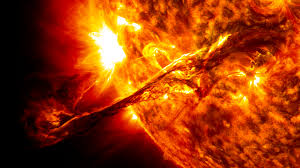Part-2 Basic astronomy knowledge series. Learn about Sun here.

The Sun and its structure.
Description about the Sun
The Sun is a star just like any of other bright stars twinkling in the sky at night. It appears big and brightest due to closeness to the earth.
Location
The Sun is the star and located at center of our solar system and lies close to the inner rim of milky way galaxy's orion arm.
Structure
Astronomers and space agencies managed to figured out the Sun's structure through various mission.Some of conclusions are
1. It does not have solid surface and it is actually a ball of gas. It is composed of helium and hydrogen. All matter in the Sun is form of gas and at high temperature plasma.
2. The Sun has following layers
- Core: Solar energy produced at the center and temperature here is about 15,000,000 degree C.
- Radiative zone: Energy from core rises slowly in radiative zone.
- Photosphere : It is visible surface of the Sun and temperature here is about 5,500 degree C.
- Convection zone: it is just beneath of the Sun's surface.
- Chromosphere: It is thin layer of gas above the photosphere. It creates atmosphere of the Sun along with corona.
- Corona: Corona is just above of chromosphere and it is actually is thick layer of gases.
3. It is largest star of our solar system and occupied 99.8 % mass of our solar system.
4. The Sun's magnetic field is very strong and that's why it is magnetically active star. It's magnetic field also extend the Sun itself.
5.Sunspots are very large and may be up to 50,000 KM in diameter and these are cool regions, where temperature is around 3800K.

Planets and Objects revolving around the Sun.
Planets and objects revolving around the Sun are given here.
A. Inner Planets - Following four planets comes under inner planet category of our solar system.
(a) Mercury (b) Venus (c) Earth (d) Mars
B. Outer Planets- Following four planets comes under outer planet category of our solar system.
(a) Jupiter (b) Saturn (c) Uranus (d) Neptune
C. The area beyond the Neptune are known as trans-neptunian region.
D. The Pluto and Charon comes under Kuiper belt region.
E. Other than planets, there are various objects revolving around the Sun like Asteroids, Ceres, Centaurs etc.

First mission to the Sun.
The first mission to observe the Sun were "Pioneer" launched by NASA in 1959 to 1968. There are lots of mission launched till date to study the Sun's structure and its surroundings.
The term heliophysics is used to denote the physics of entire the Sun from core to corona. There were lots of heliophysics flight programs conducted by NASA. View the picture to know more.
India's future plan for the Sun
Indian Space Research Organisation (ISRO) has scheduled a launch of 100 kg satellite named " Aditya" in year 2015-2016.
What is solar flare ?
Solar flare is a sudden, rapid and intense brightening structure observed around the Sun's surface. Flares are produced when magnetic energy is suddenly released from solar atmosphere.
This flares ejects the electrons, ion and atom in to the space through the corona. Solar flares affects the various layers of solar atmosphere.











